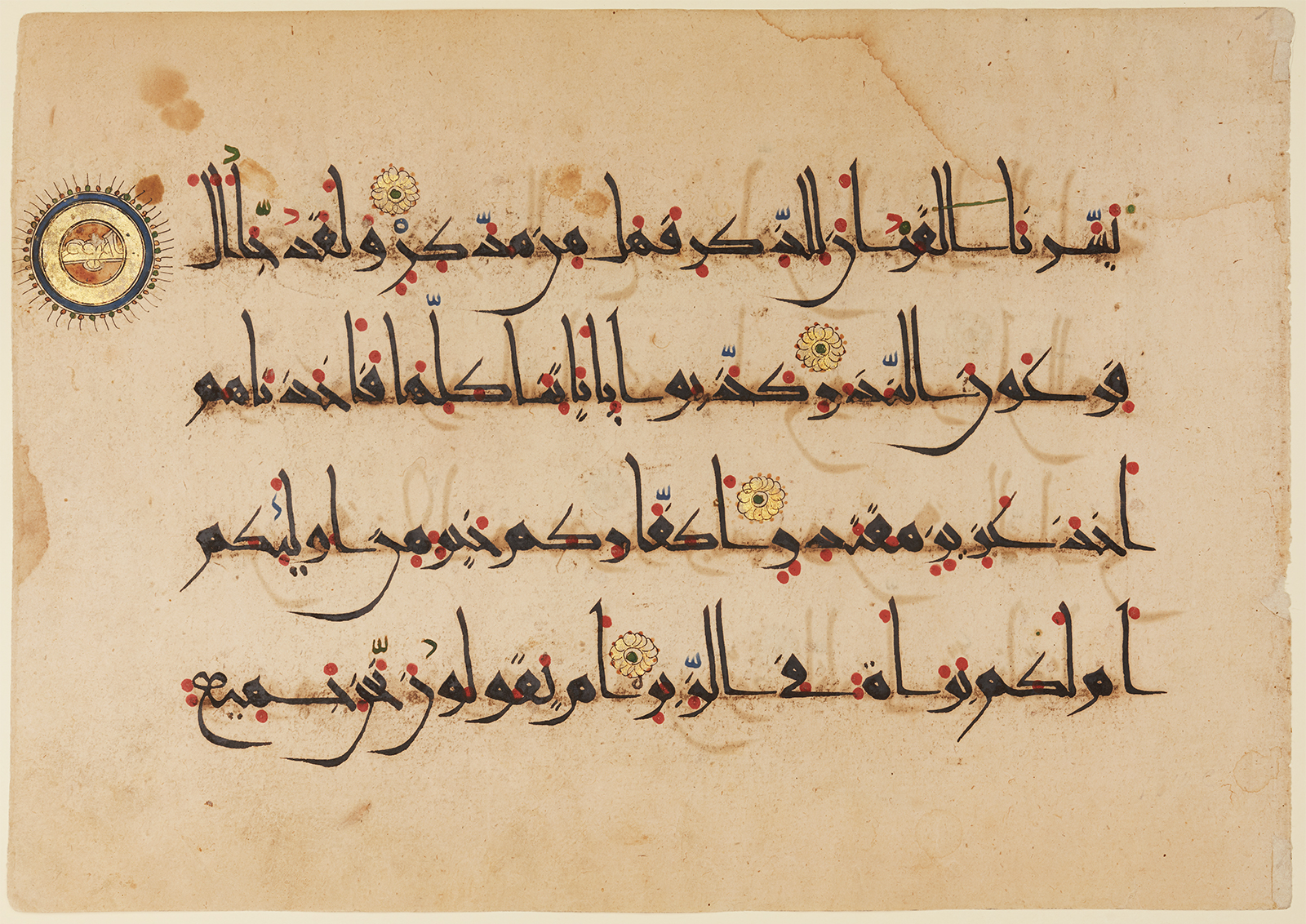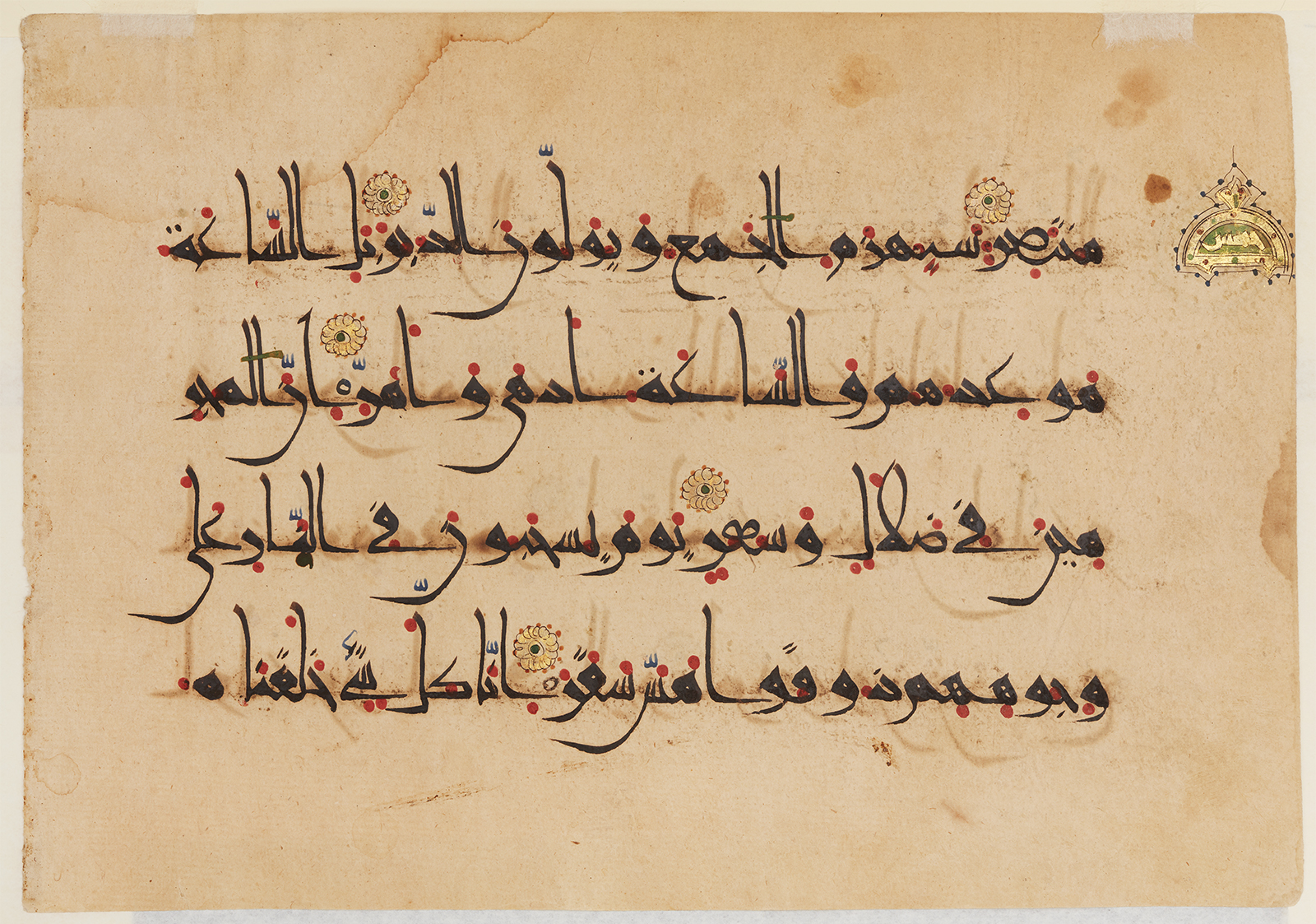Click on the image to zoom
Qur’an Folio
- Accession Number:AKM222
- Place:Iran, Isfahan
- Dimensions:24.1 × 34.2 cm
- Date:late 10th century
- Materials and Technique:ink and gold on paper
This folio belongs to the last volume of a four-part Qur’an copied in the city of Isfahan, in central Iran, in the late 10th century. Its text comprises excerpts from verses 40 through 49 of Sura 54, entitled Surat al-Qamar (Chapter of the Moon). On each side of the folio, four verses written in black ink and punctuated by red dots serve as markers to assist in reading the text.[1] A gold rosette with a blue centre indicates the beginning of each verse, and the ending of each grouping of ten verses is marked by a larger, golden medallion inscribed with the corresponding number.
Further Reading
By the late 10th century, Qur’ans were largely written in a vertical format, as can be seen in a leaf within the collection of the Art Institute in Chicago.[2] The horizontal orientation of this folio in the Aga Khan Museum Collection harkens back to earlier copies of the Qur’an.[3] Rather than using the angular, kufic script of such older manuscripts, however, it uses a new calligraphic style referred to as “Eastern kufic” or “broken cursive.” Appearing in Iran during the 10th century,[4] this new style featured letters more elongated and narrow in form.[5] Its introduction was also accompanied by a shift from parchment (animal skin) to paper as a primary medium for transcribing text, particularly in regions of the Eastern Mediterranean and Iran.[6]
Surat al-Qamar alerts disbelievers to the punishments that may lie in store for them on the Day of Judgment.[7] The first verse describes a cataclysmic lunar event—the splitting of the moon in two (shaqq al-qamar)—which serves as a harbinger of the apocalypse and as a confirmation of Muhammad’s prophethood.[8]
The verses read, in part:
54:46: Surely the Hour will be the moment of their promise, and that
moment will be calamitous and distressing
54:47: Surely the sinners are misguided and insane.[9]
The verses that follow this opening describe events during which other, earlier communities, such as the people of Noah, or the Pharaoh, ignored God’s warnings. Their behaviour is admonished by the repeated line, “Easy we have made the Qur’an to understand; so is there anyone who will be warned?” [10]
The cleaving of the moon is understood to have been a public event, witnessed not only by Muhammad’s community in Mecca but also by the whole world, thus operating as an irrefutable sign of Muhammad’s appointment as prophet.[11] The moon was also the emblem of the Prophet Muhammad’s tribe, the Quraish. Therefore, the portentous cleaving of the moon may have also served as a metaphor for the division that occurred within the Quraish tribe after the advent of Islam: some members converted, while others remained pagan.[12]
“Broken” or “Eastern kufic” continued to be used as a calligraphic style until the 11th century, and calligraphers who worked in the Eastern kufic style produced Qur’ans for a wide variety of purposes, including secular patrons. In contrast, calligraphers copying Qur’ans in the earlier, kufic style, such as a Qur’an palm leaf in the Aga Khan Museum Collection (AKM480), would have been produced exclusively by religious scholars.[13] The owner and origins of the late 10th-century folio—and, by extension, the Qur’an copy from which it comes—remain unknown.
— Michelle al-Ferzly
Notes
[1] Déroche, The ‘Abbasid Tradition: Qur’ans from the Eighth to the Tenth Centuries, 154–55, and Dutton, “Red Dots, Green Dots, Yellow Dots and Blue,” 115–40.
[2] See 1925.521, https://www.artic.edu/artworks/16141/qur-an-leaf-in-eastern-kufic-script
[3] The horizontal orientation of this folio in the Aga Khan Museum Collection harkens back to earlier copies of the Qur’an (AKM480), which were written in angular, kufic script.
[4] Soucek, “Folios from a Qur’an Manuscript,” 90–91.
[5] Whelan, “Writing the Word of God,” 113–47.
[6] Schimmel, “Islamic Calligraphy,” 9.
[7] Gruber, “Signs of the Hour,” 40–60.
[8] Rodinson, “La lune chez les arabes et dans l’Islam,” 165–66.
[9] Ali, Al-Qur’ān, 460.
[10] Ibid., 458–59.
[11] Gruber, The Moon, 18.
[12] Ali, Al-Qur’ān, 460.
[13] Whelan, “Writing the Word of God,’” 124.
References
Ahmed, Ali. Al-Qur’ān: A Contemporary Translation. Princeton, New Jersey: Princeton University Press, 1993. ISBN: 9780691074993
Déroche, François. The ‘Abbasid Tradition: Qur’ans from the Eighth to the Tenth Centuries A.D., The Nasser D. Khalili Collection of Islamic Art, Vol. 1. London and Oxford: The Nour Foundation, Azimuth Editions, and Oxford University Press, 1992. ISBN: 9780197276006
Dutton, Yasin. “Red Dots, Green Dots, Yellow Dots and Blue: Some Reflection on the Vocalisation of Early Qur’an Manuscripts — Part I.” Journal of Qur’anic Studies 1.1. (1999): 115–40. DOI: 10.3366/jqs.1999.1.1.115
Gruber, Christiane, ed. The Moon: A Voyage Through Time. Toronto, ON: Aga Khan Museum, 2019. ISBN: 9781926473154
Rodinson, Maxime. “La lune chez les arabes et dans l’Islam.” In La lune: mythes et rites, ed. Philippe Derchain. Paris: Editions du Seuil, 1962, 151–215. ISBN: 9782020027762
Schimmel, Annemarie and Barbar Rivolta. “Islamic Calligraphy.” The Metropolitan Museum of Art Bulletin 50.1 (1992): 1–56. DOI: 10.2307/3263914
Soucek, Priscilla P. “Folios from a Qur’an Manuscript.” In Masterpieces from the Department of Islamic Art in the Metropolitan Museum of Art, New York: Metropolitan Museum of Art; New Haven, Connecticut: Distributed by Yale University Press, 2011, 90–91. ISBN: 9780300175851
Whelan, Estelle. “Writing the Word of God: Some Early Qur’an Manuscripts and their Milieux, Part I.” Ars Orientalis (20): 113–47.
Note: This online resource is reviewed and updated on an ongoing basis. We are committed to improving this information and will revise and update knowledge about this object as it becomes available.




